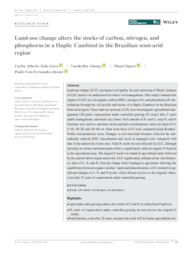Land-use change alters the stocks of carbon, nitrogen, and phosphorus in a Haplic Cambisol in the Brazilian semi-arid region.
Land-use change alters the stocks of carbon, nitrogen, and phosphorus in a Haplic Cambisol in the Brazilian semi-arid region.
Autoria: GAVA, C. A. T.; GIONGO, V.; SIGNOR, D.; FERNANDES JUNIOR, P. I.
Resumo: Land- use change (LUC) can impact soil quality. In semi- arid areas of Brazil, impacts of LUC need to be understood for better soil management. This study evaluated the impact of LUC on soil organic carbon (SOC), nitrogen (N), and phosphorus (P) dis-tributions through the soil profile and stocks of a Haplic- Cambisol in the Brazilian Semi- arid region. Three land- use systems (LUS) were investigated: agricultural man-agement (30years), regeneration under controlled grazing (25years) after 5years arable management, and native dry forest. Soil contents of P, total C, total N, and N fractions were used to calculate stocks and their stoichiometric ratios for layers 0? 5, 5? 10, 10? 20, and 20? 40cm. Data from these LUS were compared using Kruskal? Wallis non- parametric tests. Changes to soil microbial biomass reflected the sub-stantially reduced SOC concentration and stock in managed soils compared with that of the natural dry forest area. Total N stock was not affected by LUC, although increases in nitrate and ammonium offset a significantly reduced organic N fraction in the agricultural area. The largest P stock was found in agricultural land, followed by the grazed fallow regeneration site. LUC significantly influenced the stoichiomet-ric ratio of C, N, and P, with the change from Caatinga to agriculture affecting the equilibrium between organic residues? input and mineralization. LUC resulted in sig-nificant changes to C, N, and P stocks, which did not recover to the original values, even after 25years of regeneration under controlled grazing.
Ano de publicação: 2022
Tipo de publicação: Artigo de periódico
Unidade: Embrapa Semiárido
Observações
1 - Por padrão são exibidas publicações dos últimos 20 anos. Para encontrar publicações mais antigas, configure o filtro ano de publicação, colocando o ano a partir do qual você deseja encontrar publicações. O filtro está na coluna da esquerda na busca acima.
2 - Para ler algumas publicações da Embrapa (apenas as que estão em formato ePub), é necessário ter, no celular ou computador, um desses softwares gratuitos. Sistemas Android: Google Play Livros; IOS: iBooks; Windows e Linux: software Calibre.
Acesse outras publicações
Acesse a Base de Dados da Pesquisa Agropecuária (BDPA) para consultar o acervo completo das bibliotecas da Embrapa.

